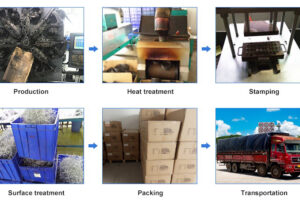Torsion Spring Production: A Comprehensive Overview of Manufacturing Processes

Torsion springs play a vital role in many mechanical and industrial applications, providing rotational force and storing energy. The production of torsion springs requires precision engineering and careful attention to detail to ensure optimal performance and reliability. This article aims to provide a comprehensive overview of the production process for torsion springs, highlighting the key steps and considerations involved in their manufacturing.
1. Design and Specification:
The first step in torsion spring production is the design and specification phase. Engineers and designers work closely with clients to understand their specific requirements and application needs. Factors such as torque, angular deflection, dimensions, material selection, and expected lifespan are considered during this phase. Computer-aided design (CAD) software is often utilized to create accurate spring designs, ensuring optimal functionality and performance.
2. Material Selection:
Once the design is finalized, the appropriate material for the torsion spring is selected. Common materials include high carbon steel, stainless steel, music wire, and phosphor bronze. Material selection depends on factors such as strength, corrosion resistance, cost, and specific application requirements. The chosen material must be capable of withstanding the expected load and environmental conditions.
3. Wire Forming:
The main process of torsion spring production is wire forming.
The wire forming process involves shaping the chosen material into the desired spring shape. This is typically done using CNC (Computer Numerical Control) machinery. The wire is fed into the machine, and the CNC program controls the movement of the machine to bend the wire accurately according to the design specifications. Careful calibration and precision are essential to ensure consistent and accurate wire forming.
4. Heat Treatment:
After wire forming, the torsion springs production undergo heat treatment to enhance their strength and durability. The heat treatment process involves subjecting the springs to controlled heating and cooling cycles. This helps to improve the spring’s hardness, toughness, and resistance to fatigue. Various heat treatment methods, such as quenching and tempering, are employed based on the material composition and desired spring properties.
5. Coiling:
The coiling process involves tightly winding the wire into a helical shape. Specialized machinery, such as coiling machines or winding equipment, is used to achieve precise and uniform coiling. The number of turns and the pitch of the coil are critical factors that determine the spring’s torque and angular deflection. Quality control measures are implemented to ensure consistent coil shape and dimensions.
6. Finishing and Surface Treatment:
To enhance the performance and longevity of torsion springs, surface treatment may be applied. This can include processes such as shot peening, electroplating, or coating with protective materials. Surface treatments help improve corrosion resistance, reduce friction, and enhance the overall aesthetics of the springs. Care is taken during the finishing process to maintain the spring’s dimensional accuracy and avoid any potential damage.
7. Inspection and Quality Control:
Upon completion of the production process, torsion springs undergo rigorous inspection and quality control measures. This involves checking the dimensions, coil pitch, torque, surface finish, and other critical parameters to ensure that the springs meet the specified requirements. Non-destructive testing methods, such as visual inspection, dimensional measurement, and load testing, may also be employed to validate the spring’s performance and durability.
Conclusion:
The production of torsion springs involves a series of precise and carefully orchestrated steps. From design and material selection to wire forming, heat treatment, coiling, and finishing, each stage contributes to the overall quality and performance of the springs. By adhering to stringent quality control measures, manufacturers can produce torsion springs that meet the specific requirements of various mechanical and industrial applications, ensuring reliable and efficient operation.







